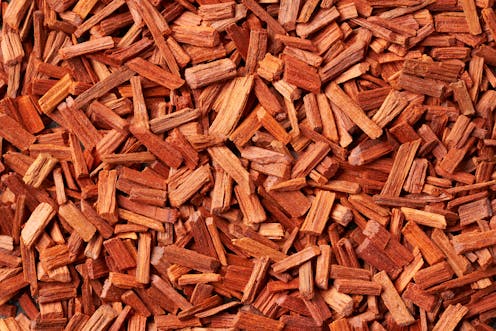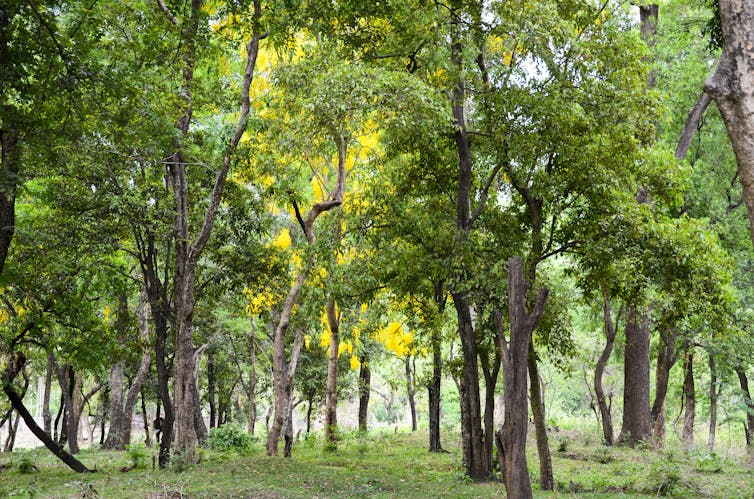
Conserving or protecting natural resources, like landscapes or products, can involve limiting people’s access or use. When natural resources are connected to cultural, religious or spiritual practices, conservation needs to consider both biological and cultural diversity.
Indian or red sandalwood (Santalum album), highly valued for its wood and oil, is a natural resource with significant economic and cultural value. The fragrant wood is used for carvings, furniture and in buildings, while the oil distilled from its heartwood has perfume, incense and medicinal applications.
In this episode of The Conversation Weekly, we speak with a chemist, an environmental historian and an environment and society researcher on why cultural preservation is key to the sustainable management of natural resources like sandalwood.
Cultural and medical applications
Danny Hettiarachchi is a chemist and adjunct research fellow at the University of Western Australia. A wood of particular significance to him because of his personal cultural connections, Hettiarachchi researches sandalwood cultivation and its applications.
Not only is sandalwood historically significant to Asian, African and Middle Eastern cultural practices as a perfume, incense or medicine, but it gained increasing popularity in the West for its properties that made it an ideal perfume fixative.
“Sandalwood is one of the best vehicles or fixatives in perfumes,” says Hettiarachchi. “It has been there from some of the earliest perfumes created in western or modern perfume styles.”

A history of endangerment
Ezra Rashkow is an environmental and South Asian historian at Montclair State University in the U.S. His research considers historical environmental conservation policies as they relate to the endangerment of natural and cultural resources.
Rashkow describes sandalwood as a natural resource that has often been regulated for various political and economic reasons.
“As early as the 1790s, really, in India, under the ruler of what’s now the Mysore region in Karnataka state, I believe it was 1792 when Tipu Sultan declared Indian sandalwood a royal tree and designated it as a protected species.”
Later, British colonial forces — who had already exploited other sandalwood species throughout the Pacific Islands — placed Indian sandalwood under their protection, while they harvested the tree for trade with China.
“Sandalwood finds an extremely important place in early colonial world history because sandalwood was one of the very few commodities that the Chinese were willing to trade for gold and silver,” Rashkow explains.
The demand for sandalwood, along with its overharvesting to meet this demand, resulted in very few sandalwood trees remaining in India. Because it is a hemiparasitic tree, cultivating it had been challening until recently.
Sandalwood’s availability is also complicated by a fungus that causes spike disease and deforestation, as well as the fact that it can take up to 20 years for a tree to reach maturity.

Intertwining nature and culture
Nature became separated from culture beginning with the Renaissance period, and this has increased throughout the Industrial era.
Jules Pretty, professor of environment and society at the University of Essex in the United Kingdom, studies human-environment relations.
“Nature and culture, they are the same thing. They have always been the same thing in human history until a kind of separation of nature and people (came along) with agriculture, cities, modern economies, and so forth.”
Pretty describes sandalwood as a perfect example through which to explore the relationships between nature and culture.
“A lot of people value sandalwood. It’s closely intertwined into cultures and people feel as though it’s a central part of their lives.”
Pretty believes that lessons about sustainability can be learned from the management of sandalwood. “It is a sacred tree in many communities in southern India, for example, and because it has that kind of characterization, that value of being sacred, then it’s looked after in a particular kind of way, which again, gets us back to thinking about sustainability.”
This episode was hosted by Nehal El-Hadi and written and produced by Nehal El-Hadi and Mend Mariwany, who is also the show’s executive producer. Eloise Stevens does our sound design, and our theme music is by Neeta Sarl.
You can find us on Twitter @TC_Audio, on Instagram at theconversationdotcom or via email. You can also subscribe to The Conversation’s free daily email here. A transcript of this episode will be available soon.
Listen to “The Conversation Weekly” via any of the apps listed above, download it directly via our RSS feed or find out how else to listen here.
Danny Hettiarachchi is a technical product specialist at Quintis Sandalwood. He has received Australian government and industry scholarships and grants towards studies and conferences on sandalwood. Hettiarachchi serves as the expert witness on sandalwood for the Western Australian Government and the State Public Prosecutor, and is a member of the International Standards Organisation’s committee on essential oils and the Australian Society of Cosmetic Chemists.
Daniel Merino does not work for, consult, own shares in or receive funding from any company or organisation that would benefit from this article, and has disclosed no relevant affiliations beyond their academic appointment.
This article was originally published on The Conversation. Read the original article.







